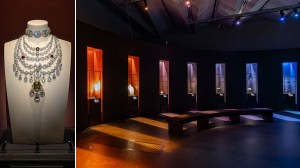Asif Khan, the award-winning architect who designed , had an emotional response when trying on La Patiala—one of the necklaces on display. Made for an Indian ruler in 1928, it’s lavishly set with over 960 carats of diamonds. But Khan wasn’t thinking about its worth.
“I was thinking, who would have been alive from my family [when it was made]?” he says. “That their great-grandson would be wearing the jewels of a maharaja—I don’t think anyone would have imagined it.”
Cartier’s La Patiala chest piece is one of hundreds of jewels on display at London’s Victoria & Albert Museum.
V&A
The necklace, one of over 350 items on display in the new show, entitled “Cartier,” is presented in a group of pieces worn by various royals. Each of the pieces, which includes a rose-shaped brooch once owned by Princess Margaret and an aquamarine-and-diamond tiara on loan from Princess Anne, is surrounded by a different hue. Khan, who is colorblind, said he chose the rainbow gradient to represent different times of the day. “The light that you see in the background is the light of Windsor at twilight, and in the foreground is the red of Delhi at sunset,” he says.
Forging such an emotional connection between visitors to the show, which opened on April 12, and the items in it wasn’t easy. Each one, selected by Helen Molesworth, the V&A’s senior curator of jewelry, and Rachel Garrahan, was chosen to demonstrate how brothers Louis, Pierre, and Jacques Cartier turned the family business into a globally recognized brand.
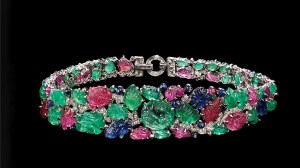
This sapphire-, emerald-, and ruby-set bandeau is emblematic of Cartier’s Frutti style, taking inspiration from the Indian practice of carving gemstones. It was owned, appropriately, by Lady Edwina Mountbatten, the last vicereine of India, in 1928.
Cartier
From their boutiques and workshops in New York, Paris, and London, the trio helped their father Alfred develop a singular aesthetic that became recognizable and coveted across the globe. In the process, they created a series of house codes that set the standard for what luxury looked like in the 20th century and beyond. (Their work popularized India’s “Tutti Frutti” combination of emeralds, sapphires, and rubies in the west; inspired an enduring love of the panther; and cemented Art Deco as a timeless style.)
“That they are still a household name today has a lot to do with the creative vision they put in place,” Garrahan says. Here, she pinpoints the pieces that exemplify their enduring ethos.
-
Desk Clock on Inkstand, 1908
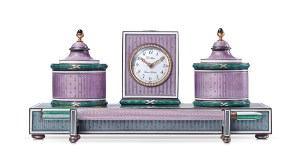
Image Credit: Nils Herrmann The Cartier brothers spent a lot of time on the road to expand their business beyond Paris. In Russia, they secured a number of wealthy clients whose taste for the finer things largely had been dictated by Fabergé, the imperial-courte jeweler. This inkstand demonstrates how “they take inspiration from those Fabergé enameled pieces, but they do something different with it,” Garrahan explains. “This gorgeous, silvery lilac color is singularly Cartier.”
-
Stomacher Brooch, 1913
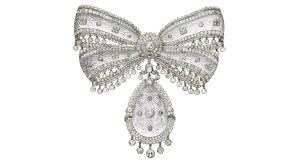
Image Credit: Cartier From its founding in 1847, Cartier had largely contracted with independent jewelry across Paris. This brooch represents the aesthetic shift that happened when Louis, the eldest of Alfred Cartier’s three sons, brought design in-house. According to Garrahan, “What Louis had the foresight to realize is that you can build the reputation of your house if you are controlling the output.” In this case, that means intricately carved rock crystal with an array of platinum-set diamonds in the maison‘s widely imitated garland style.
-
Panthère-Pattern Wristwatch, 1914
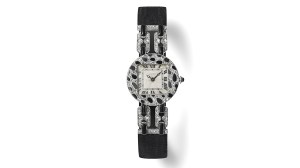
Image Credit: Cartier This World War I-era design, crafted from diamonds and onyx, is the earliest example of the Panthère motif appearing on a timepiece. It presages both the house’s obsession with big cats and the Art Deco style Cartier would eventually become associated with. “It’s an abstract realization of the panther,” Garrahan says. “At the same time that they’re doing this garland style, they’re moving to this more stark, more modernist-inspired styling.”
-
Sekhmet Brooch, 1925

Image Credit: Vincent Wulveryck This brooch, one of Garrahan’s favorite pieces, was made during the wave of homages to Egyptian culture that followed the discovery of King Tut’s tomb. The glazed-earthenware (or faience) body of Sekhmet, goddess of war, is dressed up with precious gems. It’s a sensitive example of the house “studying the past and creating something for the present,” Garrahan says.
-
Diamond and Emerald Necklace, 1932
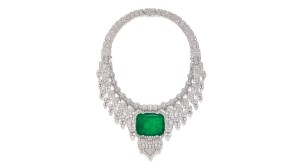
Image Credit: Nils Herrmann This sumptuous necklace was made for Beatrice Forbes, Countess of Granard—one of around 450 so-called dollar duchesses, or American heiresses who married into the European aristocracy during the Gilded Age. “She loved her jewels, and she was not shy about showing them off,” Garrahan says. The necklace represents a move away from the sautoir styles of the 1920s, “but the motifs surrounding it are so inspired by Islamic art. You see that study of other cultures coming through.”
-
Aquamarine and Diamond Tiara, 1937
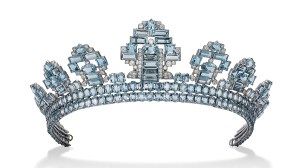
Image Credit: Vincent Wulveryck The coronation of King George Vi inspired an unprecedented number of tiara orders in 1937. “Tiaras had already gone out of fashion in Paris and New York at this stage, but in London, they were still a requirement of court dress,” Garrahan says. This example’s bold Art Deco shapes are emblematic of the U.K. branch’s style. Its gems are also representative of another facet of the post-Great Depression era. “Using a semiprecious stone, like aquamarine, was so fashionable at the time,” she says.
-
Panthère Brooch, 1989
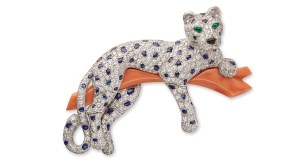
Image Credit: Marian Gerard A recurrent motif for the house, panthers evoke a sense of assertive, elegant femininity—a quality embodied by Jazz Age socialite Marchesa Luisa Casati, who also kept the big cats as pets. This piece is one of a group that will be displayed in an all-white forest scent Khan’s team created. “He’s lolling on a coral branch, and those three limbs move, so there’s a certain tongue-in-cheek-ness to it, but it’s still exquisitely made,” Garrahan says.
-
Panthère Collar, 1990
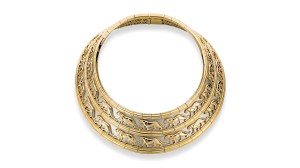
Image Credit: Marian Gérard This collar, designed by Micheline Kanoui, was chosen to represent how widely the Cartier Panthère design has traveled across the company’s archives. “It really embodies the power jewels of the ’90s and ’90s, when bold yellow-gold designs were in vogue,” Garrahan says. “We thought it more that deserved its place among the other panther jewels on display.”
Credit: robbreport.com

